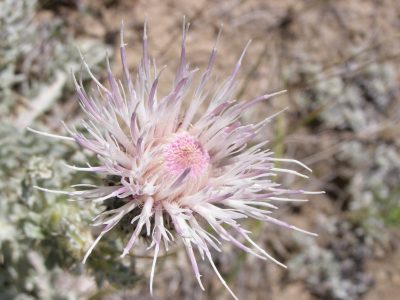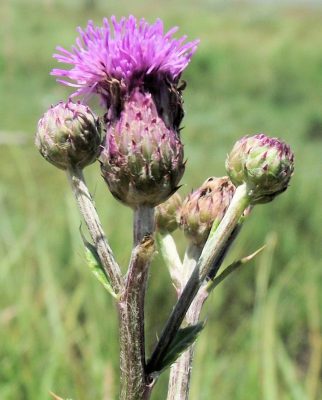This time of year, there are windrows to bale, county fairs and rodeos to attend, pastures to check, and livestock breeding decisions to make. A thistle infestation is the last thing anyone wants to see as they hustle around their working lands.
But not all thistles are noxious or invasive. Many of Wyoming’s native thistles provide key habitat for pollinators and winter food for songbirds. For this reason, land managers are encouraged to identify thistles before implementing control strategies. Native species provide ecosystem benefits and are not a risk for outcompeting other plants in their community. Knowing which thistles are harmless and which are noxious invasive species can save time and money by eliminating unnecessary interventions.

Thistles belong to the sunflower family (Asteraceae), with gray or green foliage and flowering heads that range from pale white and lavender to reddish purple and violet. They often have spines or prickles on leaf margins and around the flower heads.
Most thistle species that grow in the High Plains have a biennial growth cycle. In the first year, the plants grow as short, vegetative rosettes of leaves that capture and store energy from the sun. In the second year, these energy stores fuel the growth of an upright stalk and flowers that produce seed.
A few notable species, including the invasive Canada thistle and the native Wyoming thistle, follow a perennial growth cycle, with mature plants growing back each year from the same root base. These species also reproduce from seeds.
The state of Wyoming has designated four non-native thistles as noxious weeds. These are the Canada thistle (Cirsium arvense), Musk thistle (Carduus nutans), plumeless thistle (Carduus acanthoides) and Scotch thistle (Onopordum acanthium). All are known for their ability to outcompete native plants.
One challenge of managing noxious thistles is their ability to produce large quantities of highly mobile seeds. Individual thistle seeds have a plume of hairs, called a pappus, which allows the wind to disperse them over large distances. Effective management interventions take place before plants have released seed.
This means paying attention to surroundings while checking fences, haying, and going about day-to-day business. Land managers should note any changes and seek to identify unfamiliar plants so they can intervene before noxious plants establish at a damaging level. In weed management, this concept is known as Early Detection and Rapid Response (EDRR).
When invasive thistle species are present and a management tool is needed, many options are available. Integrated Pest Management (IPM) is a system that describes these options, which can be used alone or in tandem.
Cultural control methods include preventative measures that reduce introduction of noxious species, like cleaning boots and gear when moving from field to field. Since invasive thistles readily disperse by the wind, it can be difficult to prevent their establishment outright.

Physical or mechanical control works well for isolated patches of thistles. Using a shovel or hoe to chop out isolated plants before they set seed is an effective control method for biennial species. However, with Canada thistle, this may increase the spread by splitting up rhizomes; other control methods may be necessary.
Biological controls are living species that prey on the target organism. Musk thistles, for example, are damaged by the feeding activity of the musk thistle rosette weevil. These insects develop in the immature rosette of the thistles and stunt their growth.
Biological control of Canada thistle has been attempted with the Canada thistle gall fly and a stem-mining weevil, but with limited success. More recently, rust fungus control of Canada thistle has yielded promising results when inoculum is applied during the rosette stage.
Chemical control of invasive thistles using herbicides that kill on contact is an option when the strategies described above are not suitable. If chemical control of invasive thistles is necessary, land managers should work with their local weed and pest district. Cost-share options are available in most counties.
Noxious thistle species can quickly overtake an environment and are expensive to eradicate once established. On the other hand, native thistle species are not invasive and provide a wide array of ecosystem benefits. Knowing the difference can save land managers time and money during the growing season. For comprehensive information on how to distinguish native and non-native thistles, check out the Wyoming Thistle Field Guide: Native and Non-native online at https://bit.ly/wy-thistle-guide.
Micah Most is a University of Wyoming Extension agriculture and natural resources educator based in Johnson County. He can be reached at mmost@uwyo.edu or (307) 684-7522.




